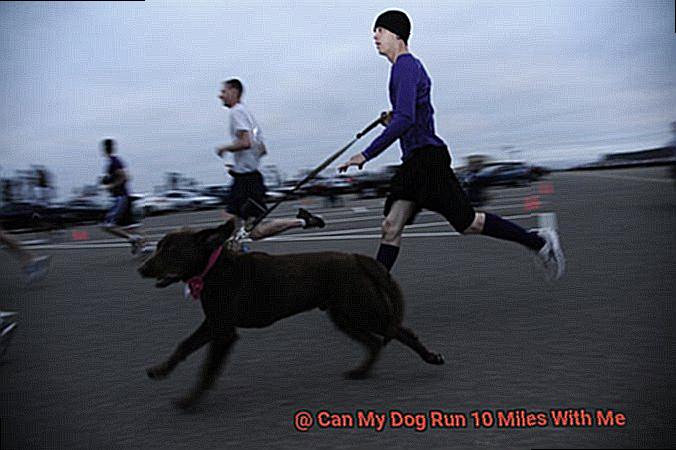Can My Dog Run 10 Miles With Me?
Are you a fitness fanatic who loves to hit the pavement for long runs?
And do you have a furry sidekick who’s always by your side? If that’s the case, you’re probably wondering if your pup can keep up with your 10-mile adventures.
Well, look no further. In this blog post, we’ll tackle the burning question on every dog owner’s mind: Can my dog run 10 miles with me?
Running with your dog can be an incredible way to strengthen your bond, stay fit, and get some fresh air together. But before you lace up those running shoes, there are a few things to consider.
So grab a cup of joe, kick back, and let’s find out if your four-legged buddy is destined to be your ultimate running partner.
Assessing Your Dog’s Fitness Level for a 10-Mile Run
Contents
- 1 Assessing Your Dog’s Fitness Level for a 10-Mile Run
- 2 Breeds Suited for Long-Distance Running
- 3 French Bulldogs and Long-Distance Running
- 4 Training and Conditioning Tips for a 10-Mile Run
- 5 Environmental Factors to Consider Before a 10-Mile Run
- 6 Age Considerations When Planning a 10-Mile Run
- 7 The Benefits of Running 10 Miles With Your Dog
- 8 Consulting With Your Veterinarian Before Starting an Intense Exercise Regimen
- 9 Conclusion
If you’re a proud owner of a French Bulldog, you know they’re full of personality and charm. However, when it comes to intense exercise like a 10-mile run, it’s essential to assess their fitness level. In this article, we’ll dive into the factors that can determine if your Frenchie is up for the challenge. Remember, your dog’s health and happiness should always be the top priority.
Consult with Your Veterinarian:
Before embarking on any intense exercise regimen, it’s crucial to consult with your veterinarian. They will evaluate your dog’s overall health and provide guidance based on their specific needs and capabilities.
Consider Breed and Size:
French Bulldogs have adorable squished faces, but their brachycephalic skull shape can make it challenging for them to tolerate strenuous exercise. While some breeds are built for endurance, Frenchies may struggle due to their compromised respiratory system. Keep this in mind when assessing their fitness level.
Evaluate Age and Exercise Requirements:

Puppies are still growing, while senior dogs may have joint or mobility issues. These factors can affect their ability to handle long distances. Adjust exercise accordingly and consult with your vet for age-appropriate activities.
Assess Current Fitness Level:
Start by evaluating your dog’s current fitness level through shorter runs or brisk walks. Monitor their breathing rate, energy levels, and recovery time after exercise. If they struggle to keep up or show signs of fatigue quickly, it may indicate they are not ready for a 10-mile run.
Gradual Increase in Distance:
Just like humans, dogs need time to build endurance. Gradually increase the distance you run with your Frenchie over time. This allows their muscles and cardiovascular system to adapt to the increased demand.
Pay Attention to Signs of Discomfort:
During exercise, it’s crucial to pay attention to any signs of discomfort or distress. Watch out for limping, excessive panting, or disorientation. If any of these occur, stop the activity immediately and seek veterinary attention if necessary.
Consider Weather Conditions:
Dogs can easily overheat, especially brachycephalic breeds like French Bulldogs. Avoid running during the hottest parts of the day and provide plenty of water breaks during the run. Keep your Frenchie cool and hydrated.
Take Breaks:
During the 10-mile run, make sure to take breaks for your Frenchie to rest, drink water, and catch their breath. This helps prevent fatigue and reduces the risk of overexertion.
Listen to Your Dog’s Cues:
Your Frenchie may not be able to communicate verbally, but their body language speaks volumes. If they show signs of stress or discomfort, respect their limits and find alternative ways to exercise and bond with them.
Breeds Suited for Long-Distance Running
Well, you’ve come to the right place. In this post, we’ll dive into the world of breeds that are best suited for long-distance running. While French Bulldogs may not be the first breed that comes to mind when you think of marathon runners, fear not. There are still plenty of other breeds out there that can join you on those epic runs.

Labrador Retriever:
Labradors are like the Energizer bunnies of the dog world. They have boundless energy and an athletic build that allows them to go the distance. Plus, their friendly nature makes them the perfect running companion.
Border Collie:
If you’re looking for a four-legged running partner with brains and brawn, look no further than the Border Collie. These intelligent dogs were bred to work hard and have the endurance to keep up with long runs.
Weimaraner:
The sleek and elegant Weimaraner is not only a stunning breed but also an excellent choice for long-distance running. With their slender build and impressive stamina, they can tackle those miles with ease.
Vizsla:
With their reddish coat and muscular physique, Vizslas are not only eye-catching but also fantastic running partners. Their natural athleticism and endurance make them well-suited for pounding the pavement alongside you.
Siberian Husky:
While French Bulldogs may prefer a cozy spot on the couch, Siberian Huskies were born to run. These snow-loving dogs have incredible stamina and strength, making them perfect for long-distance runs.

Australian Shepherd:
Despite their misleading name, Australian Shepherds are American through and through. These highly energetic dogs thrive on exercise and will happily join you on your running adventures.
German Shorthaired Pointer:
If you’re searching for a breed that combines athleticism, intelligence, and beauty, look no further than the German Shorthaired Pointer. These dogs have a lean and muscular body built for endurance.
Rhodesian Ridgeback:
Originating from Africa, the Rhodesian Ridgeback is a breed known for its strength, agility, and remarkable stamina. They’ll keep pace with you effortlessly during those long runs.
Remember, each dog is unique, so it’s important to assess your French Bulldog’s individual capabilities before hitting the pavement together. While Frenchies may not be known for their long-distance running abilities, they can still enjoy shorter bursts of exercise and playtime. And who knows? Maybe your Frenchie will surprise you with their endurance.
French Bulldogs and Long-Distance Running
We all know that our squishy-faced friends are more famous for their snuggles than their sprinting skills. But did you know that with some precautions and considerations, your Frenchie can join you on a 10-mile run? That’s right. So, before you lace up your running shoes and grab the leash, let’s dive into what you need to know about training your French Bulldog for long-distance running.
Know Their Limits
First things first, it’s essential to understand the physical limitations of French Bulldogs. Their adorable brachycephalic skull shape, with its shorter snout, can make it harder for them to breathe and regulate body temperature during intense exercise. Plus, their compact bodies and short legs may not give them the endurance or speed of other athletic breeds. So, keep this in mind as you plan your running adventures.
Consult Your Vet
Before hitting the pavement, make sure to consult with your veterinarian. They can assess your Frenchie’s overall health and determine if they’re fit for long-distance running. Your vet may recommend tests to check heart and respiratory function and provide guidance on precautions or modifications to your training routine. It’s always better to be safe than sorry.
Take It Slow and Steady
When training your French Bulldog for long-distance running, start with shorter distances and gradually increase mileage over time. This gives their body a chance to adapt and build endurance without straining their joints and muscles. Don’t forget to provide regular breaks during the run and keep them hydrated with access to water. After all, nobody likes a dehydrated pup.

Weather Watch
French Bulldogs are sensitive to extreme temperatures, especially heat. So, when planning a long-distance run, be mindful of the weather conditions. Running in hot weather can put our furry friends at risk of heatstroke and respiratory distress. Opt for cooler times of the day, like early mornings or evenings, and avoid hot pavement or surfaces that could burn their paws.
Fuel Their Adventure
Proper nutrition is key when preparing your Frenchie for long-distance running. Consult with your vet to ensure you’re feeding them a balanced diet that supports their activity level. They may recommend supplements like joint support to keep them in tip-top shape. After all, a healthy pup is a happy pup.

Listen to Your Frenchie
During your run, pay attention to your Frenchie’s cues. If they’re showing signs of fatigue, discomfort, or distress, like excessive panting or lagging behind, it’s time to take a break or call it a day. Pushing them beyond their limits can lead to injuries or health complications. So, always prioritize their safety and well-being over your personal fitness goals.
Training and Conditioning Tips for a 10-Mile Run

French Bulldogs may not be the first breed that comes to mind when you think of long-distance running, but with proper training and conditioning, they can still enjoy a 10-mile run. Before embarking on this journey, it’s important to consider your dog’s breed, age, health, and fitness level.
French Bulldogs have a brachycephalic skull shape and compromised respiratory system, which can make strenuous exercise challenging for them. However, with the right approach and precautions, you can safely train your French Bulldog for a 10-mile run.
Gradual Increase in Distance
To prepare your French Bulldog for a 10-mile run, start with shorter distances and gradually increase mileage over time. This allows their body to adjust and build endurance. Begin with short runs of about 1-2 miles and slowly increase the distance by no more than 10% each week. This gradual progression helps prevent injuries and allows your dog’s muscles and joints to adapt to the added stress.
Consistent Training Schedule
Establishing a consistent training schedule is crucial for preparing your French Bulldog for a 10-mile run. Aim for at least three to four training sessions per week, gradually increasing the duration and intensity of each session. Consistency is key to building endurance and improving overall fitness.
Incorporate Rest Days
Just like humans, dogs need rest days to recover and prevent overexertion. Incorporate rest days into your training schedule to give your French Bulldog’s body enough time to recover and rebuild. Rest days also help prevent burnout and keep your dog mentally fresh.
Cross-Training Activities
Engaging in cross-training activities can help improve your French Bulldog’s overall fitness and prevent boredom. Consider incorporating activities such as swimming, hiking, or agility training into their routine. These activities strengthen different muscle groups and enhance endurance, making your dog more well-rounded and prepared for a 10-mile run.
Proper Nutrition
Providing your French Bulldog with a balanced diet is essential for maintaining their energy levels during training. Consult with a veterinarian to determine the appropriate type and amount of food for your dog’s specific needs. Proper nutrition supports muscle growth and overall health, ensuring that your French Bulldog has the energy needed for a 10-mile run.
Hydration
Staying hydrated is vital for both you and your French Bulldog during long-distance runs. Make sure to carry enough water for both of you and make frequent stops for water breaks along the route. Be aware of signs of dehydration, such as excessive panting, dry gums, or lethargy, and provide water as needed.
Environmental Factors to Consider Before a 10-Mile Run
Before you hit the pavement for a 10-mile run with your furry friend, it’s important to consider some key environmental factors. After all, we want to keep our pups safe, happy, and healthy during our adventures together. So, let’s dive into what you need to know.
- Temperature: Just like us, Frenchies can struggle with extreme temperatures. So, be sure to check the weather forecast and plan your run during cooler times of the day. Early mornings or evenings are ideal when the temperature is lower and more comfortable for your pup.
- Humidity: High humidity can make it difficult for our Frenchies to cool down through panting. If the humidity is high, consider reducing the intensity and duration of your run or choosing a day with lower humidity levels.
- Terrain: Our Frenchies have delicate little paws and joints that need protection. Opt for softer surfaces like grass or trails to provide better cushioning and reduce the risk of injuries. Avoid hard surfaces like pavement or concrete that can strain their joints.
- Air Quality: If you live in an urban area with high pollution levels, poor air quality can be detrimental to your Frenchie’s respiratory system. Check the air quality index before heading out and avoid running in heavily polluted areas.
- Allergens: Just like humans, our Frenchies can be sensitive to allergens like pollen or dust. Be mindful of areas with high allergen concentrations that can trigger allergic reactions in your pup.
- Wildlife and Hazards: Keep an eye out for potential wildlife or hazards along your route that may pose a threat to your Frenchie’s safety. Aggressive animals, poisonous plants, or hazardous terrain should be avoided to ensure a safe and enjoyable run.
Age Considerations When Planning a 10-Mile Run
Running with your French Bulldog can be a fun and rewarding experience for both of you. However, it’s important to take your dog’s age into consideration when planning a 10-mile run. In this guide, we will explore the age-related factors that can affect your dog’s ability to handle long-distance running.
Puppies and Young Dogs:
Puppies and young dogs are still growing and developing physically. Their bones, joints, and muscles are not fully matured, making them more susceptible to injuries from high-impact activities like running. It is generally recommended to wait until a dog is at least 12-18 months old before starting them on long-distance running.
Older Dogs:
Just like humans, dogs can experience age-related issues such as arthritis or joint stiffness. These conditions can make long-distance running uncomfortable or even painful for older dogs. Before embarking on a 10-mile run with an older dog, it is crucial to consider any underlying health conditions and consult with a veterinarian.
Breed Considerations:
Different dog breeds have varying levels of endurance and physical capabilities. Some breeds, like Border Collies or Siberian Huskies, are naturally suited for long-distance running due to their high energy levels and endurance. However, brachycephalic breeds like French Bulldogs have shorter noses, which can make it harder for them to breathe efficiently during exercise. This can lead to respiratory distress and overheating, making it more challenging for them to handle a 10-mile run.
Fitness Level:
Before attempting a 10-mile run, it is important to assess your dog’s current fitness level. Dogs that are already active and regularly engage in exercise are more likely to handle longer runs better than those who lead sedentary lifestyles. Gradually building up their endurance through shorter runs and increasing the distance gradually over time can help prepare them for a 10-mile run.
Listening to Your Dog:
During the run, it is crucial to be attentive to your dog’s cues. Pay attention to signs of fatigue or discomfort, such as excessive panting, lagging behind, or reluctance to continue running. Dogs cannot communicate verbally, so it is essential to be observant and responsive to their body language. If your dog is struggling during the run, it is better to cut it short and try again another day rather than pushing them beyond their limits.
By considering these age-related factors and taking the necessary precautions, you can make an informed decision about whether your French Bulldog is ready for a 10-mile run. Remember, the well-being and safety of your furry companion should always be the top priority.
The Benefits of Running 10 Miles With Your Dog
Embarking on a 10-mile run with your French Bulldog can be an exhilarating adventure that offers a plethora of benefits for both you and your furry friend. In this article, we will explore the numerous advantages of running 10 miles with your French Bulldog, highlighting how it can strengthen your bond, improve physical fitness, provide mental stimulation, and more. So, grab your running shoes, leash up your pup, and let’s dive into the exciting world of running with your French Bulldog.
Strengthening the Bond:
Running together is an excellent way to deepen the bond between you and your French Bulldog. Sharing this active experience creates a sense of teamwork and companionship, enhancing your relationship and fostering trust.
Tiring Out Your Energetic Frenchie:
French Bulldogs are known for their boundless energy. By running 10 miles, you can tire them out and prevent destructive behavior at home. A tired Frenchie is a happy Frenchie.
Building Physical Fitness:
Regular exercise like running helps your French Bulldog maintain a healthy weight and build strong muscles. It promotes cardiovascular health, leading to a longer and happier life for your furry companion.
Mental Stimulation:
Running provides mental stimulation for your French Bulldog as they explore new environments, encounter different sights, sounds, and smells. It keeps their curious minds engaged and satisfied.

Stress Relief:
Running is a natural stress reliever for both humans and dogs. The endorphins released during exercise improve mood and reduce anxiety. Enjoy the therapeutic benefits of a run with your Frenchie.
Motivation for Your Fitness Goals:
Having a running buddy who is always excited to hit the pavement can boost your motivation and commitment to your own fitness goals. Your Frenchie’s enthusiasm will inspire you to stay consistent and enjoy the journey.
Socialization Opportunities:
Running 10 miles with your French Bulldog provides excellent opportunities for socialization. You may encounter other runners or walkers along the way, allowing for positive interactions with people and other animals.
Training on the Run:
Running with your Frenchie can also serve as a training opportunity. Reinforce commands like “heel” or “stay” while on the run, enhancing their obedience skills and making exercise even more productive.
Fun and Bonding Experience:
Above all, running together is simply a fun and bonding experience for both you and your French Bulldog. Enjoy the outdoors, explore new trails, and create lasting memories together.
Consulting With Your Veterinarian Before Starting an Intense Exercise Regimen
Embark on an exhilarating adventure with your French Bulldog as you lace up your running shoes, leash up your furry friend, and dive into the exciting world of running together, strengthening your bond, improving physical fitness, providing mental stimulation, and creating lasting memories along the way. But before you hit the pavement, it’s important to consult with your veterinarian. Why, you ask? Well, let’s dive into the reasons why it’s crucial to consult with your vet before starting an intense exercise regimen for your French Bulldog.
Assessing Overall Health and Fitness
Your veterinarian is like a superhero with a stethoscope. They have the expertise to assess your dog’s overall health and determine if they are fit for intense activities. Just like us humans, dogs have different levels of fitness and endurance. Some breeds are naturally more athletic and have higher stamina, while others may struggle with long-distance running. Your vet can evaluate your dog’s breed, age, weight, and overall health to determine if they are physically capable of running 10 miles.
Considering Pre-Existing Conditions
Just like when we go to the doctor, it’s important to consider any pre-existing medical conditions your dog may have. Certain health issues could make intense exercise unsafe or even harmful for your furry companion. Conditions such as heart disease, joint problems, or respiratory issues may require specific exercise restrictions or modifications. Your vet can identify these conditions and provide guidance on how to proceed safely.
Gradual Increase in Exercise Intensity
Going from couch potato to marathon runner overnight is not advisable for anyone – including your dog. Your vet can provide guidance on how to gradually increase your dog’s exercise intensity. A proper training plan that includes shorter runs and increments in distance over time will help prevent injuries and ensure your dog’s overall well-being. Remember, slow and steady wins the race.
Customizing an Exercise Regimen
Each dog is unique, and what works for one may not work for another. Consulting with your vet allows them to customize an exercise regimen that suits your dog’s individual needs. They can provide recommendations on the appropriate duration and frequency of exercise sessions based on factors such as breed, age, and overall fitness level. Your vet knows your dog best and can tailor the plan accordingly.
Regular Veterinary Check-Ups
Regular veterinary check-ups are essential when engaging in intense exercise with your dog. These check-ups allow your vet to monitor your dog’s progress, identify any potential health concerns early on, and make necessary adjustments to the exercise regimen if needed. It’s always better to be safe than sorry.
WWpWVMr0fMs” >
Conclusion
Can your furry companion keep up with you on a 10-mile run? The answer depends on various factors, such as breed, age, and overall health. It’s crucial to consider your dog’s physical capabilities before embarking on such a distance.
When it comes to running long distances, some dog breeds are better suited than others. Breeds like Border Collies, German Shepherds, and Labrador Retrievers have the endurance and energy levels to handle extended runs. On the other hand, brachycephalic breeds like Bulldogs or Pugs may struggle due to their shorter snouts, which can make breathing difficult during intense exercise.
Age is another important factor to consider. Younger dogs generally have more energy and stamina to keep up with a 10-mile run. However, older dogs may not have the same level of endurance and could be prone to joint issues or fatigue. It’s essential to consult with your veterinarian to ensure your dog is in good health and capable of handling this distance.
Before attempting a 10-mile run with your furry friend, it’s crucial to build up their fitness gradually. Just like humans, dogs need time to condition their muscles and joints for longer distances. Start with shorter runs and gradually increase the distance over time.
During the run itself, pay close attention to your dog’s behavior and well-being. Watch for signs of exhaustion or discomfort such as excessive panting, lagging behind, or limping. Always carry water for both yourself and your pup to stay hydrated throughout the run.
In conclusion, while some dogs can certainly handle a 10-mile run alongside you, it’s essential to assess their breed, age, and overall health before attempting such a distance. Take the necessary precautions by consulting with your vet and gradually building up their fitness level.




